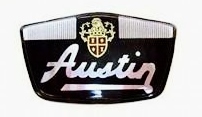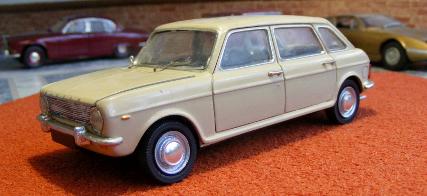
1969 Austin Maxi
The ‘Maxi’, internal design code number ADO14, had been in development since 1965 and was finally launched in the Spring of 1969. It was the last of Sir Alec Issigonis' car designs to go into production and the first new design released under the British Leyland Motor corporation.
Sir Alec had originally been asked to provide the Austin firm with three new cars, a small city car, a medium family sized car and a large more up-market vehicle, with the focus on the Medium and Large cars first. But the Suez crises and fuel shortages shifted the emphasis keenly onto the small car historically resulting in the Mini.
Once the Mini was in production the medium-sized car (ADO14/1500/Maxi), began its design gestation. By this time, it was clear to all at Austin (and those merging Austin and Morris into The British Motor Corporation), that the ageing Farina saloons and the Oxford and Cambridge saloons were losing the sales battle to more modern cars like the Ford Cortina.
Under this pressure Austin needed to address the issues of production cost, consumer price, design technology and model longevity all at the same time; arguably, Alec Issigonis was not the man to do this. Issigonis was focused on price control for the buyer and space for people and luggage in the car rather than any business concern. Issigonis retired in 1971, but not before he had driven the 2 millionth 1100/1300 (ADO16) off the production line in August of that year. Next door the 5 millionth f-w-d BMC car, a Mini Clubman, was also completed; underlining Issigonis’ design concepts as potentially very successful.
Issigonis and BMC had presented the front wheel drive transverse engine concept and BMC/BL saw this as something they couldn’t turn their back on for the sake of saving money, after all, it was a selling point that was its own reward. In the case of the Maxi this was not a problem, the car was one of the most technologically advanced designs of the time and clearly an innovative design for a family car.
The Maxi was an exciting new design that made Ford’s best-selling Cortina look outdated in style and concept. The medium-sized five-door hatchback had versatility and panache. The 1500cc OHC E-series engine, later increased to 1748cc, was solid and powerful enough to pull the car. It featured the now de-facto front wheel drive approach and was the first British five-door hatchback to include a five-speed gearbox. Of course, it rode on the now famous Moulton Hydrolastic suspension system too. Ex-Ford designer Roy Haynes led the interior design team and the Maxi’s cabin space was nothing special. Spacious and comfortable for certain, but from an aspirational point of view it was dull and somewhat generic. On the positive side, and complimenting the hatchback rear door, the rear seat could fold forwards, or backwards. Putting the rear seat back flat and reclining the front seats provided an acceptable, if spartan, sleeping option. The load space opportunities speak for themselves.
With the launch of the "Austin 1500" hatchback set for spring 1969 followed by the "Morris 1500" saloon that autumn, BMC's plans then took a blow because of the merger of BMC with Leyland. Lord Stokes, the new chairman, renamed the car “the Maxi” (in memory of the now ten-year-old Mini), then cancelled the four-door notchback saloon pushing the more conventional Morris Marina saloon, coupe and estate designs instead. Given the 1970s hatchback competition from Volkswagen (1973 Passat) and Chrysler (1975 Alpine) it seems strange that British Leyland management restricted the hatchback design to the Maxi. This despite the Morris Marina, Austin Allegro and Princess designs were all capable of carrying the concept too. In retrospect this stance, while having a negative effect on consumer usefulness, given the quality control issues BL endured probably avoided unnecessary water leaks from poorly fitting hatch back doors and further warranty claim costs! Service warranty costs were crippling BMC-BL in the late 1960s and early 1970s, so while the company was trying hard to reduce the cost considerations of manufacturing each model, Issigonis continued to plough his own furrow. From this standpoint one can understand why Lord Stokes treated Sir Alec as he did. Eventually BL would see the light and the 1976 Rover SD1 would be the first of a new range of BL hatchback designs including the Metro and Maestro. In fairness, Ford and Vauxhall didn’t get hatchback designs into their ranges until the 1980s. Launched to a fanfare of publicity on the 24th of April, 1969, in Oporto, Portugal, the Maxi was the first car launched by the new British Leyland Motor Corporation. Prior to the launch of the Maxi the board at BL were quite bullish about the new cars’ prospects. The New York Times even quoted Lord Stokes as stating: “We believe that it will create the same kind of revolution in the field of middle-class family motor cars as did the Mini in the realm of small cars”. One of the world’s earliest hatch backs, and the first from a British manufacturer, the Maxi was supposed to be a big seller and easily compete in the continental market where the concept was starting to become popular. The Maxi was also one of the earliest cars to be shown on the BBC's new “Wheelbase” car programme, the forerunner to “Top Gear”.
The advertising slogan was “All the fives”, alluding to the five doors, five seats and five gears of the high technology specification and spacious interior. Issigonis and Moulton had endowed it with keen road holding and excellent ride quality and the fifth-gear overdrive system gave quiet and speedy motorway cruising too. The Maxi did seem to be the car for all people.
Unfortunately, as soon as the critics got their hands on the production car the complaints of poor gearchange (due to unusual cable linkage system), excessive noise levels, heavy low-geared steering and lethargic performance arose. The May 1969 issue of ‘CAR Magazine’ described the launch in Portugal and added “Lord Stokes was furiously fielding criticism of the year’s non-event, the Austin Maxi, with what his transatlantic rivals would call an ‘NIH’ response: Not Invented Here.”
While some at BL attempted to distance the new firm from the design, others were quick to react to the criticisms by improving the interior, replacing the gear linkage system and offering a 1750cc engine (up from 1500) in 1970. They following up with an automatic transmission and twin carburettor engine in 1972 boosting power to 91bhp.
Production numbers saw a total of 486,273 units being built. The last Maxi, a Champagne coloured ‘L’ model registered as ‘LOV 476X’ in July 1981 is now on display at the Heritage Motor Centre in Gaydon. The Cowley production line switched over to building the Triumph Acclaim, launched in September 1981, and the British Hatchback car was consigned to history.
The Maxi never got the development it perhaps deserved. Practically unchanged throughout its 12-year production run, from 1969 and 1981, the Maxi was a practical and space efficient design, comfortable and had superior ride characteristics. It actually was loved by many who owned one and enjoyed its flexibility, but that wasn’t enough to make the design a sales success. Like the later Allegro, the Maxi was a far better car than many people admit; once the production issues were sorted out.
The Maxi never sold in the numbers it was expected to. Poor quality control and a higher price than much of the competition of the time restrained the Maxi’s sales considerably. The complaints following the Maxi’s launch terminally tarnished the car’s image, backed up by the fact that, initially at least, breakdowns were commonplace and the bodies rotted very quickly too. These failings becoming even more commonplace later in the 1970s on the Morris Marina.
Neither BL or the buying public understood the Maxi. For a buying public used to judging cars by the engine capacity and overall looks, the fifth gear was not seen as a practical economy cruise idea, but as a novelty. British Leyland themselves failed to promote the virtues of their spacious and flexible design, which, if it had been developed and exploited further might have gone beyond its five-seat capacity to become the original MPV. BL also allowed the Maxi to be slotted into the market psyche as a small estate rather than a spacious family car, which restricted the cars appeal to buyers. And, the largest engined Maxi also had to compete with other BL designs such as the ADO17 ‘1800’ and later on the Austin Princess. In the end though, the newer Cortinas were cheaper and better looking, so the consumers voted with their wallets and the Maxi failed to sell.
Today the Maxi has loyal band of followers who will enthusiastically tell the virtues of the car to anyone willing to listen. Perhaps the Maxi is another case of ‘much potential, little attention’; from BL and the buying public.







Some of the 1960s and 1970s Airfix 1/32nd scale model car kits are now really rare; incredibly rare. So rare that a mint version of the Austin Maxi, Kit # M304C (03404-7) can command a price as high as £350 today (2022). A huge return on the investment of 35p Woolworths sold the kit for back in the day. Even built, you might be looking at £60-£70.
Fortunately, the model we have was donated to us in built condition. In August 2000 Rod gave it a total restoration. Stripped to the individual parts, as much as was safe to do so, cleaned and stripped of paint the potential of this kit was extracted to provide what you see in the photographs. Not bad for a kit originally released in 1971; we’re not sure it has ever been re-released either!
It is painted with Halfords acrylic car spray paints and polished with ‘T-Cut’ for the body, the interior is brush painted with Humbrol enamel paints and Citadel acrylic ink washes. Bare Metal Foil was used for the window frames and much of the brightwork and Tamiya clear red and orange paints helped to make the rear lights and indicators stand out.
If you fancy a Maxi for your collection today, where can you get one? Well, as we mentioned, finding one of the Airfix kits (even in the built state) can be very expensive and hard to do. But two other options do exist. In the 1980s a 1/32nd scale Austin Maxi ‘Bodyshell with bumpers and windows’ was released by Highway32. But this too is now very hard to find and still not cheap.
The best option is to contact Pendle slot racing and see if they can be persuaded to sell their PCS Austin Maxi Resin Kit # PCS-B003 again. Available as a Body Kit or a complete kit with all the parts to build into a working slot car this is the best priced option. When they have it in stock of course.
RETURN TO :-
